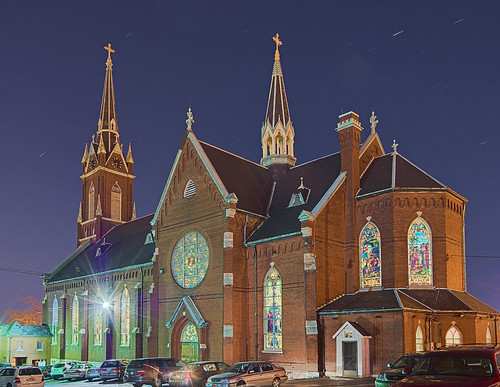
This present church dates from the end of the 19th century. Sometimes considered to be a part of the Soulard neighborhood, this church has a very small natural parish, the church being cut off from significant residential areas by an Interstate highway and by industrialization. So, like many urban parishes in Saint Louis, this beautiful and historic church has a special apostolate.
In 1983, the late Msgr. Bernard E. Granich was named pastor of Saint Agatha, and was granted permission by Archbishop May to celebrate the Mass in Latin here according to liturgical books preceding the Second Vatican Council. Initially, this Mass was offered on first Saturdays, and after Pope John Paul II promulgated his motu proprio Ecclesia Dei adflicta, every Sunday. Until 2005, the church was under the pastorate of Father James Rodis, assisted by the late Father Xavier Albert.
In 2005, after a controversy which led to an interdict against the former Saint Stanislaus Kostka parish, Archbishop Burke transferred the Polish language apostolate to Saint Agatha. Masses and the sacraments are now offered here in both English and Polish. According to the parish website:
Parafia Św. Agaty została założona po to, by służyć duchowym potrzebom polskich emigrantów zamieszkujących okolice St. Louis. Parafia podlega bezpośrednio Arcybiskupowi St. Louis oraz Papieżowi. Żyjąc w amerykańskim społeczeństwie staramy się podtrzymywać i pielęgnować naszą bogatą tradycje. Poprzez wstawiennictwo Matki Boskiej Częstochowskiej, Królowej Polski oraz Św. Agaty, patronki naszej parafii, staramy się wypełnić powierzone nam przez Jezusa powołanie do życia w wierze katolickiej, miłości, sprawiedliwości i pokoju.This photo was taken with a series of long exposure times, and trails of stars can be seen in the sky. In preparation for the Stations of the Cross devotion, the church's lights were on inside, offering us an unusual view of the stained glass windows at night.

This is a spacious church. According to a history of the Soulard neighborhood:
The German Catholic Church of St. Agatha was organized in 1871 by Rev. J. A. Stroomberger when he found about one hundred families in the area willing to subscribe a total of $5,000 towards the erection of a church. A lot at the northwest corner of Eighth and Utah Streets was purchased and the church was dedicated on July 14, 1872 by Bishop Ryan. The two story brick structure had a school on its first floor with an auditorium seating 450 persons on the second floor. The cornerstone of the present church was laid in 1885 and in 1899 the transept, sacristy and sanctuary were added to the structure. A nuns' residence was built in 1892 and a new school and hall was completed in 1908.

An early comprehensive history of Saint Agatha's, in German, can be read here.

Detail of the altar and reredoes. Above the tabernacle of Our Lord is a painting of Saint Agatha (died A.D. 251), virgin and Roman martyr, with the instruments of her martyrdom. This altar, I was told, was made by a parishioner who attended the Indult Latin Mass that was formerly celebrated here.
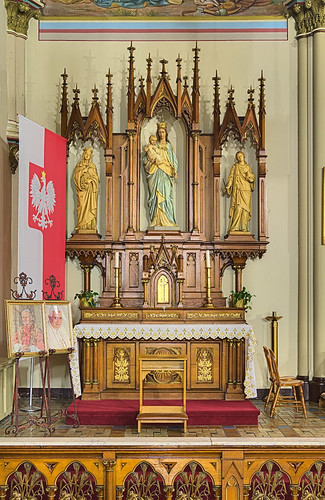
Mary's altar, with the Polish flag and photos of Popes John Paul II and Benedict XVI.
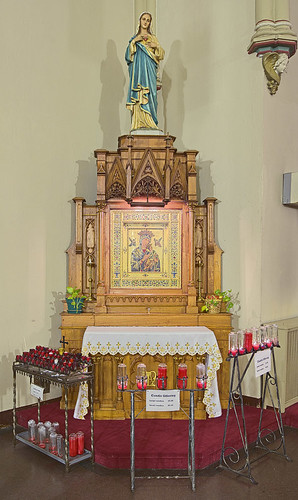
Our Mother of Perpetual Help.
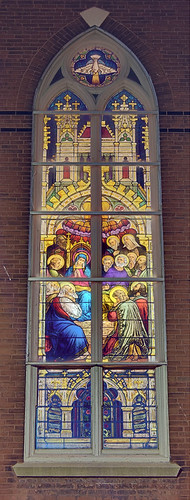
Stained glass window of Pentecost.
When the time for Pentecost was fulfilled, they were all in one place together. And suddenly there came from the sky a noise like a strong driving wind, and it filled the entire house in which they were. Then there appeared to them tongues as of fire, which parted and came to rest on each one of them.
— Acts 2
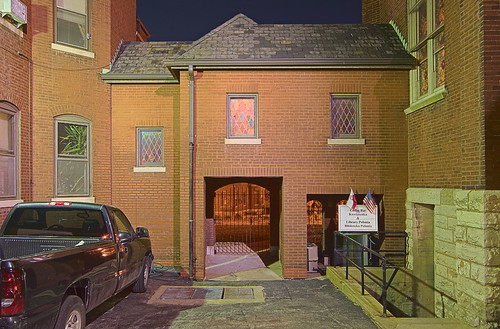
Archway joins the church to the rectory; stairs lead down to the church hall, where Lenten fish fries are presently being held. The sign reads Coffee Bar and Library Polonia, in both English and Polish. I've been here twice this Lent.

The former school, now for sale. The loss of the Catholic school system is a great tragedy of the day, which not only harms Catholic children, but also society at large, as education is increasingly centrally controlled without alternative. I was told that the parish also had a girls' school, which was destroyed by construction of Interstate 55.
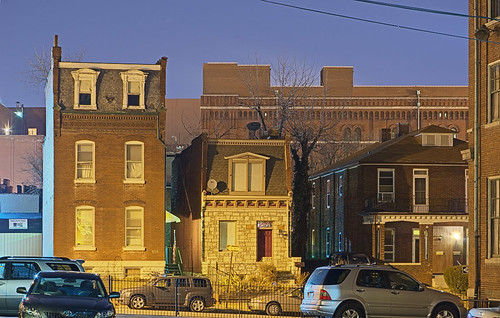
Some neighboring houses with the Anheuser-Busch brewery in the background.
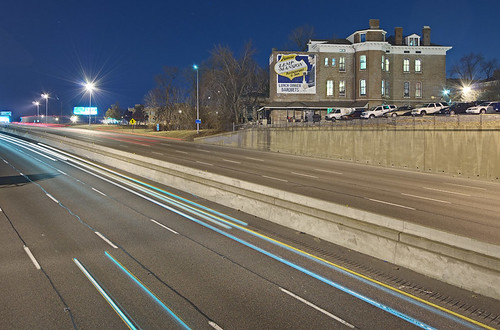
Behind the church is Interstate 55. In the background is the Lemp Mansion, now a restaurant.
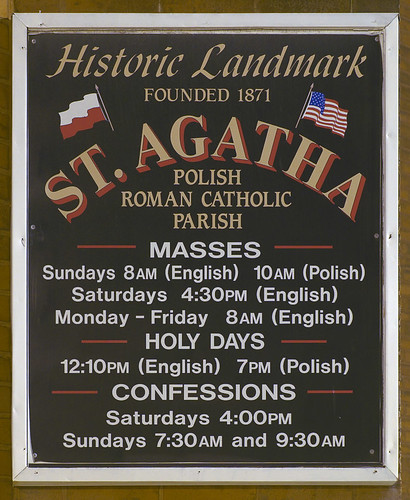
Address:
3239 South 9th Street
St Louis, Missouri 63118


There is a lot of positive "meat" in this post. I would like to engage you with regard to Catholic Education. I have no idea what percentage of elidgible Catholics students actually attend Catholic schools in the St. Louis metro area. On the surface the area seems to benefit from a large number of Catholic High Schools in particular in the metro or suburban areas. Many of them appear to have newer well equipped state of the art facilities. My concern is whether a complete cross section of Catholics are being served by these schools or if as in the deep south where so called Christian Schools are nothing more that a escape act from the mandates of integration. As a Catholic I would hope that every effort is being made by these newer suburban schools to extend their services via scholarhips or subsidies to those who can least afford a Catholic education and that they are not simply enclaves of the well to do.
ReplyDeleteMany of the high schools, which are private, offer scholarships and work study for students. As to integration, it depends on which high school you are speaking of. Some schools, like Cardinal Ritter Prep, near SLU, are nearly 100% African American. Other schools, like St. Elizabeth Academy (my alma mater) are a mix of students from different backgrounds.
ReplyDeleteWe also have to be realistic on getting students to these Catholic Schools. Gone are the days when a student could simply walk to school. A student may well be able to afford a school but can't get transportation.
have you ever heard this one? Butcher: I am selling hamburger for 50cents a pound today but I am fresh out!" Sure scholarships and work studies are available but if the child cannot get to school because of transportation ( the school moved away from them) then they are guilty of being "fresh out"! IF we are truly Catholic we had better be finding a way for the child to get to school!
ReplyDeleteThe reality is, there are not too many active Catholics left in the city. Reason for which these old parish schools are dying.
ReplyDeleteWhat it takes is people to live in these neighborhoods and go to the schools. Not many of us can say we do that.
It's too bad they are selling this old school. It's awesome inside w/ a seemingly rich history. But, you can't force the hood to be Catholic and making the majority of city residents see the worth in spending their money on education instead of... is difficult to say the least.